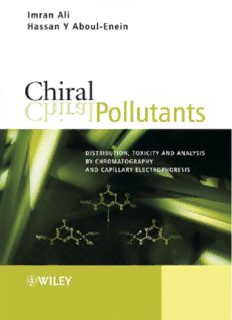
Chiral Pollutants: Distribution, Toxicity and Analysis by Chromatography and Capillary Electrophoresis PDF
Preview Chiral Pollutants: Distribution, Toxicity and Analysis by Chromatography and Capillary Electrophoresis
Chiral Pollutants: Distribution, Toxicity and Analysis by Chromatography and Capillary Electrophoresis Imran Ali National Institute of Hydrology, Roorkee, India and Hassan Y. Aboul-Enein King Faisal Specialist Hospital, Riyadh, Saudi Arabia Copyright2004 JohnWiley&SonsLtd,TheAtrium,SouthernGate,Chichester, WestSussexPO198SQ,England Telephone(+44)1243779777 Email(forordersandcustomerserviceenquiries):[email protected] VisitourHomePageonwww.wileyeurope.comorwww.wiley.com AllRightsReserved.Nopartofthispublicationmaybereproduced,storedinaretrievalsystemor transmittedinanyformorbyanymeans,electronic,mechanical,photocopying,recording,scanning orotherwise,exceptunderthetermsoftheCopyright,DesignsandPatentsAct1988orunderthe termsofalicenceissuedbytheCopyrightLicensingAgencyLtd,90TottenhamCourtRoad,London W1T4LP,UK,withoutthepermissioninwritingofthePublisher.RequeststothePublishershould beaddressedtothePermissionsDepartment,JohnWiley&SonsLtd,TheAtrium,SouthernGate, Chichester,WestSussexPO198SQ,England,[email protected],orfaxedto(+44) 1243770620. Thispublicationisdesignedtoprovideaccurateandauthoritativeinformationinregardtothesubject mattercovered.ItissoldontheunderstandingthatthePublisherisnotengagedinrendering professionalservices.Ifprofessionaladviceorotherexpertassistanceisrequired,theservicesofa competentprofessionalshouldbesought. OtherWileyEditorialOffices JohnWiley&SonsInc.,111RiverStreet,Hoboken,NJ07030,USA Jossey-Bass,989MarketStreet,SanFrancisco,CA94103-1741,USA Wiley-VCHVerlagGmbH,Boschstr.12,D-69469Weinheim,Germany JohnWiley&SonsAustraliaLtd,33ParkRoad,Milton,Queensland4064,Australia JohnWiley&Sons(Asia)PteLtd,2ClementiLoop#02-01,JinXingDistripark,Singapore129809 JohnWiley&SonsCanadaLtd,22WorcesterRoad,Etobicoke,Ontario,CanadaM9W1L1 Wileyalsopublishesitsbooksinavarietyofelectronicformats.Somecontentthatappears inprintmaynotbeavailableinelectronicbooks. LibraryofCongressCataloging-in-PublicationData Aboul-Enein,HassanY. Chiralpollutants:distribution,toxicity,andanalysisby chromatographyandcapillaryelectrophoresis/HassanY.Aboul-Eneinand ImranAli. p.cm. Includesbibliographicalreferencesandindex. ISBN0-470-86780-9(cloth:alk.paper) 1.Environmentaltoxicology.2.Enantiomers--Toxicology.3. Enantiomers--Separation.4.Chromatographicanalysis.5.Capillary electrophoresis.I.Ali,Imran.II.Title. RA1226.A262004 615.9(cid:1)02--dc22 2003024672 BritishLibraryCataloguinginPublicationData AcataloguerecordforthisbookisavailablefromtheBritishLibrary ISBN0-470-86780-9 Typesetin11/13ptTimesNewRomanbyLaserwordsPrivateLimited,Chennai,India PrintedandboundinGreatBritainbyAntonyRoweLtd,Chippenham,Wiltshire Thisbookisprintedonacid-freepaperresponsiblymanufacturedfromsustainableforestry inwhichatleasttwotreesareplantedforeachoneusedforpaperproduction. Dedication Dedicatedtothememoriesofmylateparents: BasheerAhmedandMehmudanBegum ImranAli Tomylovingfamily: Nagla,Youssef,FaisalandBasil fortheirsupportandencouragement HassanY.Aboul-Enein Contents Preface xiii Acknowledgements xv AbouttheBook xvii AbouttheAuthors xix 1 Introduction 1 1.1 TheImportanceoftheEnvironment 1 1.2 EnvironmentalPollutants 2 1.3 ChiralityanditsOccurrence 3 1.4 TheChemicalEvolutionofChirality 4 1.5 TheElectronicTheoryofChirality 6 1.6 TheImportanceofChirality 7 1.7 NomenclatureforChiralPollutants 8 1.8 ChiralityinEnvironmentalPollutants 10 1.9 ChiralityanditsConsequencesintheEnvironment 12 1.10 TheEnantiomericRatioandFractionsofChiralPollutants 13 1.11 MethodsfortheSeparationofChiralPollutants 15 1.11.1 ChromatographicMethods 16 1.11.2 TheCapillaryElectrophoreticMethod 21 viii Contents 1.12 ChiralSelectorsinChromatographyandCapillary Electrophoresis 23 1.13 DetectioninChromatographyandCapillary Electrophoresis 27 1.14 OtherMethodsofSeparationofChiralPollutants 28 References 30 2 ChiralPollutants:SourcesandDistribution 37 2.1 Introduction 37 2.2 SourcesofContamination 39 2.3 TheDistributionofChiralPollutants 44 2.3.1 DistributioninWater 44 2.3.2 DistributioninSediment 49 2.3.3 DistributioninSoil 50 2.3.4 DistributioninAir 53 2.3.5 DistributioninAquaticandAmphibianBiota 55 2.3.6 DistributioninTerrestrialBiota 60 2.3.7 DistributioninFoodProducts 67 2.4 Conclusions 67 References 68 3 ChiralPollutants:Biotransformation,Biodegradation andMetabolism 75 3.1 Introduction 75 3.2 TheMechanismsoftheInteractionsofChiralXenobiotics inBiologicalSystems 77 3.3 TheFateofChiralPollutantsintheEcosystem 81 3.3.1 Biotransformation 81 3.4 PhotochemicalConversion 95 3.5 Metabolism 96 3.6 Conclusions 102 References 103 4 TheEnantioselectiveToxicitiesofChiralPollutants 109 4.1 Introduction 109 4.2 TheEnantioselectiveToxicitiesofPCBs 110 4.3 TheEnantioselectiveToxicitiesofHCH 116 Contents ix 4.4 TheEnantioselectiveToxicitiesofOtherChlorinated Pesticides 117 4.5 TheEnantioselectiveToxicitiesofPhosphorousPesticides 121 4.6 TheEnantioselectiveToxicitiesofPolyaromatic Hydrocarbons(PAHs) 121 4.7 TheEnantioselectiveToxicitiesofOtherXenobiotics 134 4.8 TheEnantioselectiveToxicitiesofDrugsand Pharmaceuticals 136 4.9 Conclusions 139 References 140 5 SamplePreparation 145 5.1 Introduction 145 5.2 Sampling 147 5.3 Filtration 148 5.4 Homogenization 149 5.5 Extraction 150 5.5.1 TheExtractionofSolidSamples 150 5.5.2 TheExtractionofLiquidSamples 161 5.6 MembraneMethodsinSamplePreparation 172 5.7 Clean-up 173 5.8 Pre-concentration 174 5.9 Conclusions 176 References 176 6 TheAnalysisofChiralPollutantsbyGasChromatography 185 6.1 Introduction 185 6.2 ChiralSelectors 186 6.2.1 StructuresandProperties 187 6.2.2 PreparationandCommercialization 189 6.2.3 OtherChiralGCCSPs 190 6.3 Applications 195 6.4 TheOptimizationofGCConditions 206 6.4.1 MobilePhases 207 6.4.2 Temperature 208 6.4.3 TheColumnDimensions 211 6.4.4 StructuresandTypesofChiralSelectors 212 6.4.5 TheStructuresofChiralPollutants 215 x Contents 6.4.6 Detection 215 6.4.7 OtherParameters 216 6.5 TheReverseElutionOrder 217 6.6 ErrorsandProblemsinEnantioresolution 218 6.7 TheDerivatizationofChiralEnvironmentalPollutants 219 6.8 MechanismsofChiralResolution 219 6.9 Conclusions 221 References 222 7 TheAnalysisofChiralPollutantsbyHighPerformance LiquidChromatography 229 7.1 Introduction 229 7.2 ChiralSelectors 230 7.3 Applications 233 7.4 TheOptimizationofHPLCConditions 238 7.4.1 PolysaccharideCSPs 239 7.4.2 CyclodextrinCSPs 245 7.4.3 MacrocyclicGlycopeptideAntibioticCSPs 249 7.4.4 ProteinCSPs 253 7.4.5 ChiralCrownEtherCSPs 258 7.4.6 LigandExchangeCSPs 260 7.4.7 Pirkle-typeCSPs 262 7.5 Detection 265 7.6 ChiralRecognitionMechanisms 265 7.7 Conclusions 266 References 268 8 TheAnalysisofChiralPollutantsbyMicellarElectrokinetic, CapillaryElectrochromatographic,SupercriticalFluidand ThinLayerChromatographicTechniques 273 8.1 Introduction 273 8.2 ChiralSelectors 274 8.3 MicellarElectrokineticChromatography(MEKC) 274 8.4 CapillaryElectrochromatography (CEC) 281 8.5 SupercriticalFluidChromatography(SFC) 284 8.6 ThinLayerChromatography(TLC) 287 8.7 LCversusGC 289 8.8 Conclusions 289 References 290 Contents xi 9 TheAnalysisofChiralEnvironmentalPollutants byCapillaryElectrophoresis 295 9.1 Introduction 295 9.2 ChiralSelectors 296 9.3 Applications 297 9.4 TheOptimizationofCEConditions 302 9.4.1 TheCompositionoftheBackgroundElectrolyte 304 9.4.2 ThepHoftheBackgroundElectrolyte 305 9.4.3 TheIonicStrengthoftheBackgroundElectrolyte 306 9.4.4 StructuresandTypesofChiralSelectors 308 9.4.5 TheAppliedVoltage 308 9.4.6 Temperature 310 9.4.7 TheStructuresofChiralPollutants 311 9.4.8 OrganicModifiers 312 9.4.9 OtherParameters 312 9.4.10 OptimizationbyDependentVariables 315 9.5 Detection 315 9.6 ValidationofMethods 317 9.7 MechanismsofChiralResolution 318 9.8 CEversusHPLC 319 9.9 Conclusions 320 References 321 10 PerspectivesontheAnalysisofChiralPollutants 325 10.1 Introduction 325 10.2 RegulationsonChiralityintheUSA 326 10.3 RegulationsonChiralityinEurope 327 10.4 RegulationsonChiralityinJapan 328 10.5 RegulationsonChiralityinOtherCountries 328 10.6 TheCapabilitiesofChiralAnalysisTechnologies 329 10.7 TheLarge-scaleProductionofPureEnantiomers 329 10.8 TheImpactofChiralityonEconomicGrowth 330 10.9 Conclusions 331 References 332 Index 335 Preface One of the two enantiomers of a chiral pollutant may be more toxic than theother,andabout25%ofagrochemicalsarechiralinnature–including pesticides, which are applied in agricultural and forestry activities in the form of their racemates. The biological transformation of chiral pollutants can be stereoselective, such that the uptake, metabolism and excretion of the enantiomers may be very different. Therefore, the enantiomeric composition of chiral pollutants may be changed during these processes. Themetabolitesofchiralcompoundsareoftenchiral.Therefore,topredict the exact toxicities of pollutants, determination of the concentrations of both enantiomers is essential, and hence environmental scientists are eagerly seeking techniques for their analysis. Moreover, diverse groups of people–ranging from regulators tothe materials industries,clinicians and nutritional experts, agriculturalists and environmentalists–are also now demandingdataontheratioofpollutantenantiomers,ratherthantheirtotal concentrations. Various approaches to chiral resolution have been developed for the analysis of pharmaceuticals and drugs but, unfortunately, few reports and monographs areavailableonthechiralseparationofpollutants.Therefore, we have set out to write this book, which deals with the distribution, toxicities and art of analysis of chiral pollutants by gas chromatography and liquid chromatography; that is, by high performance liquid chro- matography (HPLC), sub- and supercritical fluid chromatography (SFC),
Description: